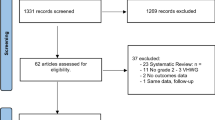Abstract
The FDA’s Center for Devices and Radiological Health (CDRH) is responsible for providing reasonable assurance of safety and effectiveness of all medical devices marketed within the US. To date, CDRH has cleared numerous hernia mesh devices for general use, but has not cleared/approved any mesh devices intended for certain specific uses, such as for infected wounds, hernia prevention, biofilm reduction, or prevention of adhesions. CDRH is requesting that manufacturers seeking specific hernia mesh device labeling claims consult with the Agency to determine the level of evidence necessary for justifying such claims.
Similar content being viewed by others
Avoid common mistakes on your manuscript.
Introduction
As numerous synthetic and biological hernia mesh device options exist, surgeons are seeking to understand how patient outcomes can be optimized by selecting the most appropriate mesh device to best achieve the operative goal for specific clinical scenarios. Although a paucity of data guiding such specific use exists, guidelines regarding the process for determining the need for hernia mesh and then choosing a specific mesh are being discussed at surgical conferences and within the surgical literature. In an effort to further inform this productive dialogue, we provide a description of the US Food and Drug Administration (FDA) regulatory process for hernia mesh device clearance/approval and the information typically submitted by manufacturers to the FDA prior to hernia mesh device marketing clearance for general indications for use. We also describe some of the types of specific indications for hernia mesh device use where the Agency has typically requested clinical study data. The scope of this article does not include mesh devices used in pelvic floor repair and orthopedic procedures.
FDA regulatory process
The US FDA Center for Devices and Radiological Health (CDRH) is responsible for ensuring the safety and effectiveness of all medical devices marketed within the US and to date has granted ~400 mesh device clearances, which represents new mesh devices together with existing mesh devices modified in design, components, method of manufacture, or indication for use.
The medical device classification system is central to the FDA’s review process and is unique to devices; the drug evaluation process does not have a parallel classification system. The Medical Device Amendments created three classification levels, based on a device’s level of clinical risk. A description of each of these classes and their key differences is provided in Table 1.
Surgical mesh for hernia repair is a Class II product evaluated under the Premarket Notification or 510(k) process. In a traditional 510(k) submission, the manufacturer seeks to demonstrate that their new device is at least as safe and effective [known as substantially equivalent (SE)] when compared to another Class II device (called the predicate device) already legally marketed within the US. The predicate device may be a similar device legally marketed by the same manufacturer or by another manufacturer. The new device should have the same intended use and technological characteristics as the predicate device and the information/data submitted by the manufacturer must be adequate to demonstrate this. The device can have different technological characteristics compared to the predicate if those new characteristics do not raise different types of questions of safety and effectiveness.
Many Class II devices can be found SE to the predicate device on the basis of comparative bench performance and preclinical data alone although a number of 510(k) submissions contain or require clinical data to demonstrate substantial equivalence.
Regulation of surgical mesh devices for general indications for use
Some of the newer hernia meshes are made of combined layers of synthetic and bioabsorbable material or contain flexible rings on their periphery or have specialized coatings. Fundamentally however, each of these various types of surgical mesh for hernia repair is evaluated and categorized as a 510(k)-regulated device, which is defined in Code of Federal Regulation, Title 21 (CRF 878.3300) as being
… a metallic or polymeric screen intended to be implanted to reinforce soft tissue or bone where weakness exists. Examples of surgical mesh are metallic and polymeric mesh for hernia repair, and acetabular and cement restrictor mesh used during orthopedic surgery.
Hernia mesh devices seeking general marketing clearance are typically cleared with the general indication “to reinforce soft tissue where weakness exists” and typically receive marketing clearance after a comparison between the predicate mesh device and new device is conducted to determine substantial equivalence with respect to such features as: biocompatibility, mechanical strength, and sterility. Additional considerations exist for biological meshes and these include description of animal source, tissue processing, and viral inactivation. Unless the new device represents a novel device composition or features that fall outside of the parameters of previously cleared predicate devices, clinical data has typically not been requested. Examples of circumstances often requiring human clinical trial data under FDA approved IDE include, but are not limited to mesh devices indicated for new indications for use, or are constructed of new materials or new combinations of materials.
Regulation of hernia mesh devices for specific indications for use
Within the general indication of “reinforcement of soft tissue where weakness exists” for all mesh devices, the FDA has cleared some hernia mesh devices for specific indications, such as repair of specific hernia types (e.g., inguinal hernia repair, parastomal hernia repair). The FDA has not cleared hernia mesh devices for use specifically in infected wounds, for hernia prevention, for biofilm reduction, or to act as an adhesion barrier and has informed individual manufacturers of the need for clinical data to justify such claims. In the case of an adhesion barrier function, a mesh device with such a claim would be considered a Class III adhesion barrier device and not regulated as a surgical mesh device.
Surgical mesh device study investigators interested in performing clinical studies evaluating new mesh devices or new intended uses for existing mesh devices can seek advice from the FDA on the type of data and the appropriate regulatory path for legally marketing the device. In order to obtain FDA input, it is our recommendation that clinical study sponsors contact the FDA in advance of planned human clinical study using the FDA’s pre-Investigational Device Exemption (preIDE) process. Submitting a pre-IDE is relatively simple and allows study investigators to obtain advice on their protocol prior to initiating a clinical study and gain input into the Agency’s expectations regarding the data requirements both before, and possibly after, obtaining clearance/approval of a mesh device. Pre-IDE interaction can also identify early whether a formal study IDE application is required before patients may be enrolled in the study. Should an IDE submission be required, pre-IDE interaction serves as advance notice for FDA to assemble an appropriate review team and acquaint the team with the mesh device before receiving the IDE. In this way, pre-IDE discussions may facilitate the IDE process, which has a statutory deadline of 30 days for FDA review. Investigators who have questions regarding CDRH’s regulatory processes can visit the CDRH home page at http://www.fda.gov/medicaldevices/default.htm or connect directly to an FDA representative by calling or emailing CDRH’s Division of Small Manufacturers, International and Consumer Assistance (DSMICA) at +1-240-2763150 or DSMICA@fda.hhs.gov.
Discussion
It is important for physicians and investigators to understand the basis on which FDA medical device clearance decisions are made and to know that, while hernia mesh devices are marketed with general indications for use, justification of specific marketing claims falling within the general indication clearance can trigger the need for clinical data if the specific indications for use raises questions of safety and effectiveness. Guidelines addressing the General to Specific Intended Use regulatory circumstance can be found in “FDA’s Guidance for Industry: General/Specific Intended Use” http://www.fda.gov/MedicalDevices/DeviceRegulationandGuidance/GuidanceDocuments/ucm073944.htm.
Additional resources for mesh device clinical investigators include:
-
“Guidance for the Preparation of a Premarket Notification Application for a Surgical Mesh” http://www.fda.gov/MedicalDevices/DeviceRegulationandGuidance/GuidanceDocuments/ucm073790.htm
and
-
Pre-IDE Program: Issues and Answers—March 25, 1999 (D99-1)
-
http://www.fda.gov/MedicalDevices/DeviceRegulationandGuidance/GuidanceDocuments/ucm126600.htm.
Author information
Authors and Affiliations
Corresponding author
Rights and permissions
About this article
Cite this article
Ashar, B.S., Dang, J.M., Krause, D. et al. Performing clinical studies involving hernia mesh devices: what every investigator should know about the FDA investigational device exemption (IDE) process. Hernia 15, 603–605 (2011). https://doi.org/10.1007/s10029-011-0872-3
Received:
Accepted:
Published:
Issue Date:
DOI: https://doi.org/10.1007/s10029-011-0872-3




